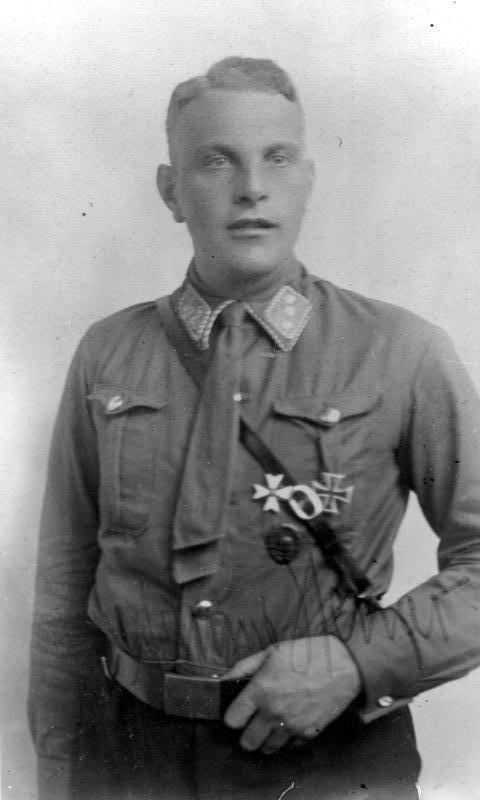Name Edmund Heines Role Political leader | ||
 | ||
Similar People Karl Ernst, Ernst Rohm, Ferdinand von Bredow, Herbert von Bose, Gregor Strasser Died 30 June 1934 (aged 36) Munich, Nazi Germany Born 21 July 1897 (age 36) Munich, Kingdom of Bavaria, German Empire Deputy to SA Stabschef In office (1 May 1931 – 30 June 1934) Preceded by Position established Succeeded by Position abolished Polizeipräsident of Breslau In office (25 March 1933 – 30 June 1934) Führer, SA-Obergruppe III Führer, SA-Obergruppe VIII In office (1 July 1933 – 30 June 1934) Preceded by Wolf-Heinrich Graf von Helldorff Succeeded by Position abolished Deputy Gauleiter of Gau Silesia In office (Early 1933 – 30 June 1934) Preceded by Karl Peschke Succeeded by Walter Gottschalk Acting Gauleiter of Gau Oberpfalz In office (June 1930 – November 1930) Preceded by Franz Maierhofer Succeeded by Franz Maierhofer Cause of death Execution by firing squad Awards Iron Cross, 1st Class, Iron Cross, 2nd Class Allegiance German Empire(1915–1918) Branch Imperial German Army Years of service 1915–1918 Rank Leutnant Battles/wars World War I | ||
EXECUTION of Edmund Heines - Brutal NAZI SA Leader & Killer Murdered during Night of the Long Knives
Edmund Heines (21 July 1897, Munich – 30 June 1934, Stadelheim Prison) was a Nazi Party leader and Ernst Röhm's deputy in the Sturmabteilung or SA.
Contents
- EXECUTION of Edmund Heines Brutal NAZI SA Leader Killer Murdered during Night of the Long Knives
- Life
- Execution
- References

Life
Heines served in World War I as a Kriegsfreiwilliger and was discharged in 1918 as a lieutenant. From 1919 to December, 1922, he served as leader of a unit in Freikorps Roßbach and later as Gruppenführer of the Munich Ortsgruppe. In December, 1922, he transferred to the Nazi Party and the SA (stormtroopers).

In 1929, he was convicted of the murder of communist Conrad Pietrzuch, who had been beaten to death by an SA gang led by Heines. The trial had to be reopened due to a technical error, and Heines soon received an amnesty because of his supposedly "patriotic" motive. That same year, he was appointed to temporarily serve as the head of a Nazi district in the Upper Palatinate region. In 1930, Heines became a member of the Reichstag for the district of Liegnitz. From 1931 to 1934, he served as an SA leader in Silesia while simultaneously working as Ernst Röhm's deputy. In 1933, Heines was on the Prussian privy council, and in May of the same year he became head of police in Breslau.
Execution

Hitler's chauffeur Erich Kempka claimed in a 1946 interview that Edmund Heines was caught in bed with an unidentified 18-year-old male when he was arrested during the Night of the Long Knives, although Kempka did not actually witness it. The boy was later identified as Heines' young driver Erich Schiewek. According to Kempka, Heines refused to cooperate and get dressed. When the SS detectives reported this to Hitler, he went to Heines's room and ordered him to get dressed within five minutes or risk being shot. After five minutes had passed by, Heines still had not complied with the order. As a result, Hitler became so furious that he ordered some SS men to take Heines and the boy outside to be executed.
Following their arrest, Heines, Röhm, and several other leaders of the SA were executed. In his speech to the Reichstag on July 13, 1934, Hitler characterized Heines as a key figure within a "small group of elements bound by similar dispositions."
Heines's younger brother, Oskar (born on 3 February 1903 in Munich) was also an SA officer. On the morning of 1 July 1934, he heard a radio report concerning the execution of his brother. Soon after, SA-Obersturmbannführer Oskar Heines, along with SA-Obersturmbannführer Werner Engels, reported to the Polizeiprasidium in Breslau. They were immediately placed under arrest by SS men. From there, they were driven that night to a forested area near Deutsch-Lissa (now Wrocław-Leśnica, Poland). At dawn on 2 July 1934, the two were shot on orders of SS-Obergruppenführer Udo von Woyrsch.
